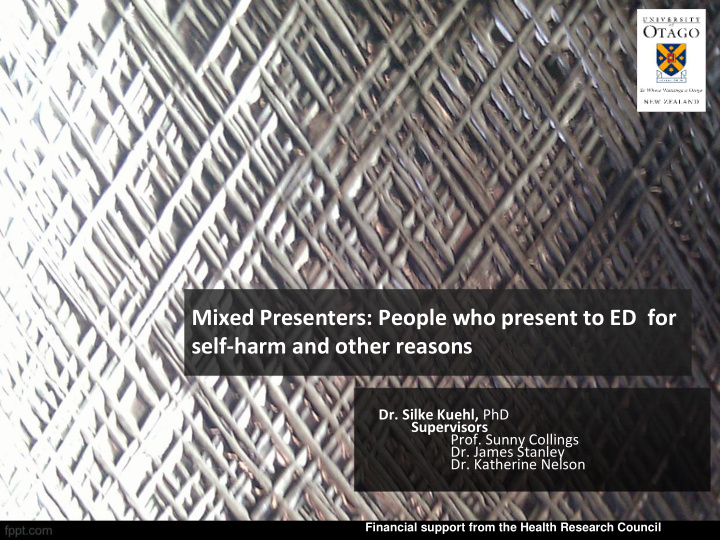



Mixed Presenters: People who present to ED for self-harm and other reasons Dr. Silke Kuehl, PhD Supervisors Prof. Sunny Collings Dr. James Stanley Dr. Katherine Nelson Financial support from the Health Research Council
Overview Background Method Qualitative, quantitative, triangulation Findings Who are Mixed Presenters? Serious self-harm risk ED management Discussion/conclusion
Background – emergency department Overcrowding Lack of privacy Focus on physical health and trauma Increasing no. of patients present for self-harm Negative staff attitudes towards self-harm
Trauma: RTA, IPV, substance misuse Background – Mixed presentations Suicide risk associated with physical illness, chronic pain, trauma (1, 2, 3, 4, 5) Frequent ED use Of those who died by suicide 43% had attended ED, 25% of these for physical reasons (6) 60% of ED patients did not communicate suicidal thoughts to staff (7). Occult suicidality in ED (8) (1) Scott et al. (2010), (2) Qin et al. (2013), (3) Anguiano et al. (2012), (4) Ilgen et al (2010); (5) Martiniuk et al. (2009); (6) Cruz et al (2011); (7) Douglas et al (2004); (8) Claassen & Larkin.(2005)
Research questions 1. Who are Mixed Presenters? 2. What is Mixed Presenters’ serious self -harm risk? 3. What is the ED management of Mixed Presenters?
Method Data from another study (MISP) Ethics approval: 3 and 8 DHBs Qualitative study: Nurse Recruiter made initial contact, face to face interviews (n=27) Quantitative study: Survival analysis (n=1921) Triangulation
Self-harm?
Qual: Who are Mixed Presenters • Chronic physical Intertwining health conditions contributed and social issues to self-harm (n=12) & self-harm • Pain exacerbated self harm • Social struggles: violence, money, daily coping, the law
I had an accident when I was seven years old. I got pushed off the top of a two-storey house. And I fell face first onto a wooden peg in the ground and I ’ ve ripped right down the centre of my face open. And I was in a coma for about 2 or 3 weeks, but ever since then I ’ ve been in pain as a kid. (Mike)
Quant: Who are Mixed Presenters? (4:1) Mixed Presenters (n=1544) 51% male, 31% Māori 54% single/separated Self-harm Only Presenters (n=377)
Qual: Serious self-harm risk Coping has limits Unpredictability of mental state Medical/ED care influenced self-harm Support people instrumental I actually felt like a failure...as a husband, a father, a failure of killing myself. So pretty much just put it down to being a failure. Just disappointed in myself ‘cause I don't like to fail (Matt)
Quant: Serious self-harm risk Kaplan-Meier plot Cumulative proportion experiencing outcome by time Self-harm Only Presenters (SHOP) Mixed Presenters (MP) Number still at risk (without event) at 6-month time points:* SHOP MP
Qual: ED management • Vulnerability “... jus’ wanna crawl in and crawl out ..” (Amelia) I think with the OD it's 'You're a naughty girl!' Whereas with chest pain it's 'Y'know you've got a condition’ (Felicia) • Limited input in care “Like you are a spare part …” (Patricia) • Inadequate assessment
When I was in ED... I went home with – well, I had 250 tramadol, 200 panadol, 200 nurofen, and 180 codeine which is what a doctor at ED sent me home with (Polly)
Quant: ED management • ⬆︐ Urgent triage codes (1-3): – Mixed Presenters 53% – Self-harm Only Presenters 69% • ⬆︐ Admissions – Mixed Presenters 27% – Self-harm Only Presenters 34% • Self-harm presentations aligned in the two groups: triage 69%, admission status 34%
Limitations • Identification of self-harm from ED data challenging – Presenter groups distinct? • Non-inpatient admissions such as respite care not included as outcome events • Participants interviewed might differ from non-participants
Conclusion Acknowledge complex health and social issues of Mixed Presenters Take self-harm risk seriously Contribute to the wellbeing of Mixed Presenters
References Anguiano, L., Mayer, D. K., Piven, M. L., & Rosenstein, D. (2012). A literature review of suicide in cancer patients. Cancer Nursing , 35 (4), E14 – E26. http://doi.org/10.1097/NCC.0b013e31822fc76c Claassen, C. A., & Larkin, G. L. (2005). Occult suicidality in an emergency department population. British Journal of Psychiatry , 186 , 352 – 353. Da Cruz, D., Pearson, A., Saini, P., Miles, C., While, D., Swinson, N., … Kapur, N. (2011). Emergency department contact prior to suicide in mental health patients. Emergency Medicine Journal , 28 , 467 – 471. http://doi.org/10.1136/emj.2009.081869 Douglas, J., Cooper, J., Amos, T., Webb, R., Guthrie, E., & Appleby, L. (2004). “ Near-fatal ” deliberate self- harm: characteristics, prevention and implications for the prevention of suicide. J Affect Disord , 79 (1 – 3), 263 – 268. http://doi.org/10.1016/S0165-0327(02)00391-9 S0165032702003919 [pii] Ilgen, M. A., Zivin, K., Austin, K. L., Bohnert, A. S., Czyz, E. K., Valenstein, M., & Kilbourne, A. M. (2010). Severe pain predicts greater likelihood of subsequent suicide. Suicide & Life-Threatening Behavior , 40 (6), 597 – 608. http://doi.org/10.1521/suli.2010.40.6.597 Kuehl, S., Nelson, K., & Collings, S. (2012). Back so soon: rapid re-presentations to the emergency department following intentional self-harm. New Zealand Medical Journal , 125 (1367), 1 – 10. Martiniuk, A. L., Ivers, R. Q., Glozier, N., Patton, G. C., Lam, L. T., Boufous, S., … Norton, R. (2009). Self-harm and risk of motor vehicle crashes among young drivers: Findings from the DRIVE Study. Canadian Medical Association Journal , 181 (11), 807 – 812. Qin, P., Webb, R., Kapur, N., & Sørensen, H. T. (2013). Hospitalization for physical illness and risk of subsequent suicide: A population study. Journal of Internal Medicine , 273 (1), 48 – 58. http://doi.org/10.1111/j.1365-2796.2012.02572.x Scott, K. M., Hwang, I., Chiu, W.-T., Kessler, R. C., Sampson, N. A., Angermeyer, M., … Nock, M. K. (2010). Chronic physical conditions and their association with first onset of suicidal behavior in the world mental health surveys. Psychosomatic Medicine , 72 (7), 712 – 719. http://doi.org/10.1097/PSY.0b013e3181e3333d
Doctors rather medicate it, scan it, suture it, splint it, excise it, anaesthetise it, or autopsy it than communicate with it. Fadima, 1997
Recommend
More recommend